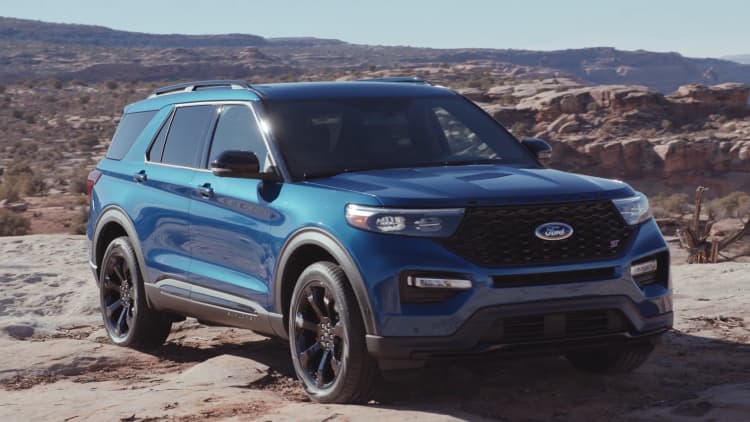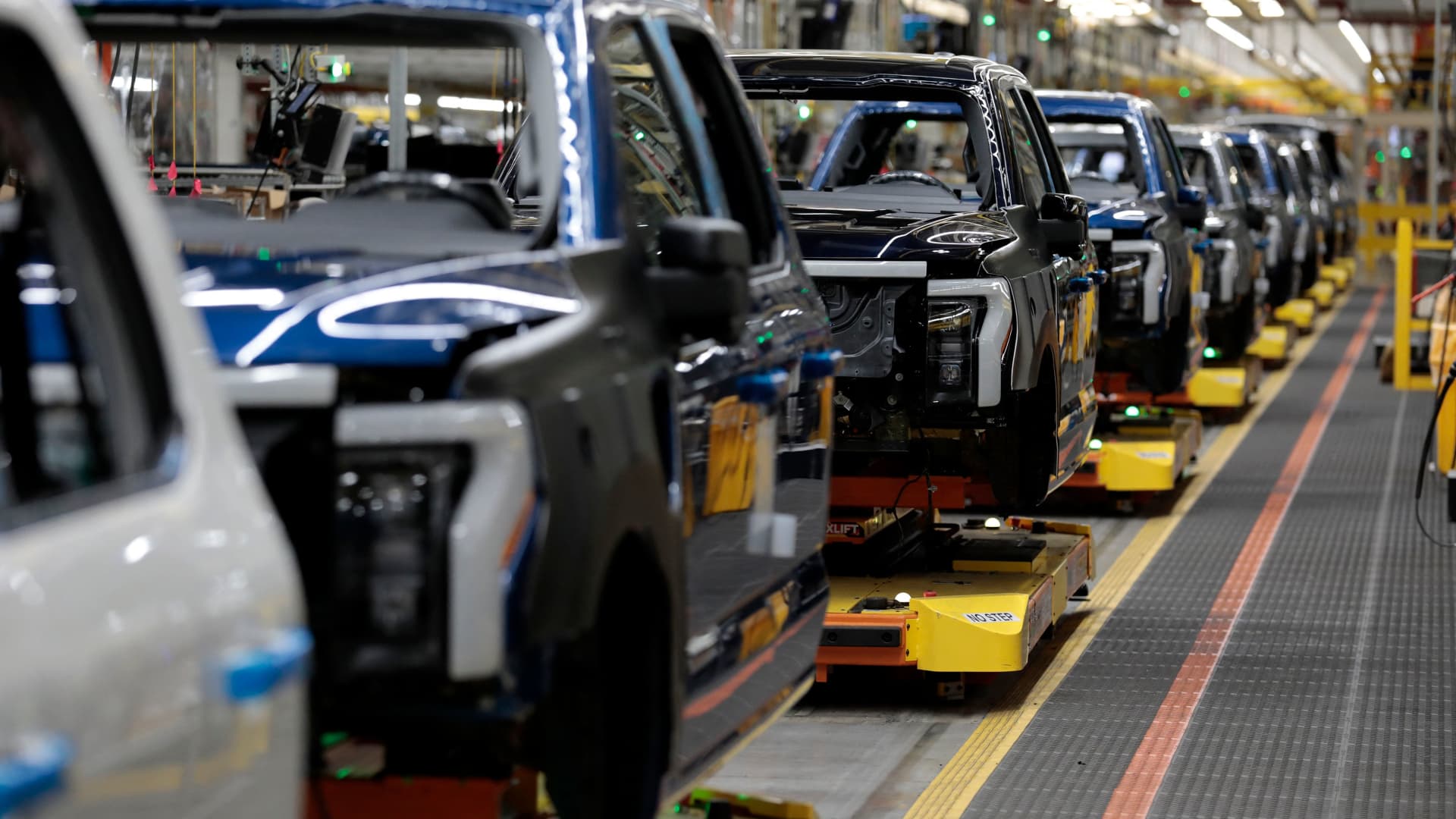Ford Motor Company’s electric F-150 Lightning on the production line at its Rouge Electric Vehicle Center in Dearborn, Michigan, on Sept. 8, 2022.
Jeff Kowalsky | AFP | Getty Images
DETROIT – When President Donald Trump hinted last week at a reprieve from 25% auto tariffs, he suggested it would be to allow automakers more time to move or increase U.S. vehicle production and parts.
“They need a little bit of time because they’re going to make them here,” Trump said April 14. “But they need a little bit of time, so I’m talking about things like that.”
While automotive executives and experts agree more time would be helpful, an extension to bolster U.S. manufacturing isn’t so simple.
For one thing, an additional 25% auto parts tariff is scheduled to take effect by May 3, which would raise the cost of a vehicle even if it’s assembled stateside rather than imported.
And for another, automakers and suppliers don’t simply “move” plants, like some politicians have called for. Relocating production lines takes years of planning and construction — and can be costly.
The actual construction of an assembly plant has to be done in conjunction with hiring workers, building infrastructure such as water and energy supplies and building out a parts supply chain, among other considerations. That’s after site determination, purchasing and any potential changes to zoning.
Such facilities, like a new 16-million-square-foot plant from Hyundai Motor, in Georgia, can require thousands of acres of land and include millions of square feet of factory space.
“All of those things have to fall in place,” said Doug Betts, an auto industry veteran who’s president of J.D. Power’s automotive division. “It’s a very, very complicated process.”
Permitting alone for a new plant can take six to 12 months. It can take another 12 months to 18 months, if not more, to build the facility, followed by another year or more in tooling and ramping up production, according to Collin Shaw, president of the MEMA Original Equipment Suppliers association.
The main kind of plants that Trump wants automakers to build in the U.S. are large, multibillion assembly plants that take years to construct. Full assembly plants employ thousands of workers and are more like manufacturing cities, made up of a body shop, paint plant, stamping and other supporting facilities.
Even smaller supplier plants that may be able to mobilize more quickly could still take years and are often built near larger plants, according to industry executives and experts.
Autoworkers at Nissan’s Smyrna Vehicle Assembly Plant in Tennessee, June 6, 2022. The plant employs thousands of people and produces a variety of vehicles, including the Leaf EV and Rogue crossover.
Michael Wayland / CNBC
“I’m convinced that localization is the way, but localizing new models that are built somewhere else in the world doesn’t happen overnight,” Christian Meunier, chairman of Nissan Americas, told CNBC. “Nissan is very fast, but it’s not going to be a matter of months. It’s a matter of years.”
Meunier said the automaker is aiming to “max out” production at its largest American production plant amid Trump’s tariffs, though he declined to specify a timeline for doing so.
This week six of the top policy groups representing the U.S. automotive industry uncharacteristically joined forces to lobby the Trump administration against implementing the upcoming tariffs on auto parts.
“President Trump has indicated an openness to reconsidering the administration’s 25 percent tariffs on imported automotive parts – similar to the tariff relief recently approved for consumer electronics and semiconductors. That would be a positive development and welcome relief,” the letter read.
New plants
The fastest way to increase U.S. production is to use existing facilities, for which the supply chains have already been established, like Nissan is planning to do.
The more costly option is to construct a new assembly plant, which can take time but comes with a trickle-down effect for the community as suppliers work to localize production of certain parts and components.
Every direct job created in vehicle manufacturing supports an average of 10.5 additional American jobs, according to a 2022 report from the Alliance for Automotive Innovation trade group.
The most recent new automotive assembly plant in the U.S. is Hyundai’s “Metaplant” in Georgia.
The $12.6 billion project, which Trump has touted as a success for American manufacturing, took roughly two and a half years to construct. That’s not including the plant’s ongoing ramp-up in production and an undisclosed length of time for site selection, permitting and other processes.
Hyundai’s timeframe was relatively quick given the amount of investment and size of the plant, which has a capacity for 300,000 vehicles annually and expected employment of 8,500 jobs by 2031.
“If you’re building a brand new one, you’re going lightning fast to get it done in two years, and you have to have everything ready to go. More likely, it’s in the four-year type of range,” said Mark Wakefield, a partner and global automotive market lead at consulting firm AlixPartners.
Jeep parent Stellantis, formerly Fiat Chrysler, took a similar construction timeframe of 2.5 years and spent $1.6 billion to convert two powertrain plants from 2019 to 2021 into Detroit’s first “new” assembly plant in nearly 30 years.
There are unique instances of automakers figuratively moving mountains and spending billions of dollars to get things done more quickly. An anomalous case outside of the U.S. was Tesla’s plant in China. The facility, with support from Chinese officials, was reportedly constructed in less than a year in 2019.
Quick actions
Short of building out entirely new facilities, there are ways to increase U.S. production far more quickly and for less cost. Specifically, if the product is made at more than one location and the automaker or supplier has additional, unused capacity.
Many automakers, such as General Motors, use multiple plants to produce their highest-volume products. The Detroit automaker produces its light-duty Chevrolet Silverado at plants in Canada, Mexico and the U.S.
The day Trump’s 25% tariffs on imported vehicles went into effect, GM said it would increase production of full-size pickup trucks at its assembly plant near Fort Wayne, Indiana, and hire hundreds of temporary employees. Such a move is essentially low-hanging fruit for a company.
Automakers protect production of their most profitable vehicles as much as possible. In the past, this has meant spending billions of dollars for a plant changeover or even dual production of older and newer models of the same vehicles.
Moving quickly can have its drawbacks. To lose as little production as possible of its Ford Explorer SUV in 2019, Ford spent $1 billion to completely retool its body shop and make other improvements to the sole Illinois facility that produces the vehicle.
The entire process for Ford took an unprecedented 30 days, but the vehicle launch was infamously flawed, costing the company billions in recalls and fixes. At the time, Ford called it “one of the most complex renovations in the company’s history.”

“Being out of production in a segment is devastating,” said Betts, who has worked at Apple as well as Stellantis and other carmakers.
Betts said most companies will do a “daisy chain” in which they build out another plant for a new model, while continuing to produce the old. It allows for an easier transition, but companies need to have the plant space and capital to pull off such a move.
Not to mention, auto companies need certainty that regulations or trade policies won’t change as construction is underway, resulting in billions of dollars in unnecessary expenses.
“It’s not a flip of the switch,” Swamy Kotagiri, CEO of Canada-based auto supplier Magna, said last week during an Auto Press Association meeting near Detroit. “We have to look at it from a pragmatic perspective. I don’t see how you can just pick up something and move. It sounds easy, but it’s not.”




